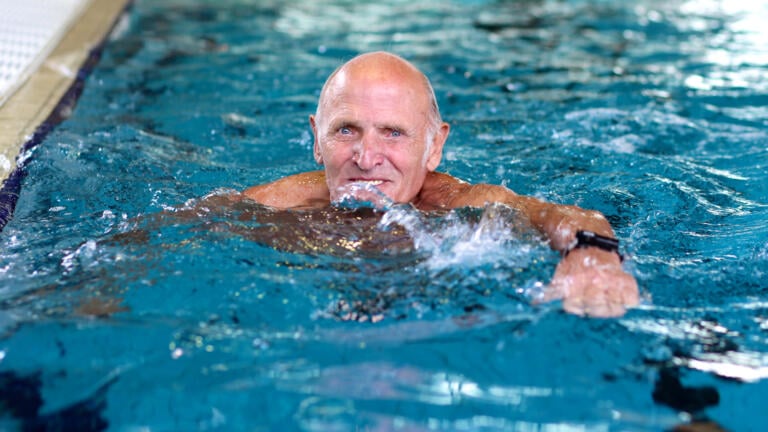
12 reasons why swimming is good for you
Julie Penfold
Swimming benefits your health and fitness – here’s why you should consider making a regular trip to the pool.
Swimming is an enjoyable way to switch off, de-stress and work on your fitness. It’s also a great low-impact, full-body form of physical activity that is suitable for many of us.
Not everyone takes to swimming like a duck to water, however, and you might find you need a little more encouragement to consider heading to the pool regularly.
That’s where we can help, with expert advice from a swimming coach – plus information on why swimming is good exercise and how to find a pool near you.
Swimming is an enjoyable way to switch off, de-stress and work on your fitness. It’s also a great low-impact, full-body form of physical activity that is suitable for many of us.
Not everyone takes to swimming like a duck to water, however, and you might find you need a little more encouragement to consider heading to the pool regularly.
That’s where we can help, with expert advice from a swimming coach – plus information on why swimming is good exercise and how to find a pool near you.
 Credit: Shutterstock/Poppy Pix
Credit: Shutterstock/Poppy PixYes, swimming is an excellent form of exercise and can benefit us in myriad ways, ranging from relieving stress and anxiety to improving your quality of life. We’ve rounded up six of the key benefits of swimming below:
No matter which stroke you do (backstroke, breaststroke, butterfly or freestyle), swimming engages all the major muscles in your body, including your legs, arms, back and core.
Swimming provides a great cardiovascular workout to strengthen your heart and lungs, too. It’s also an excellent calorie burner – but how much you burn depends on the stroke you choose to do and how quickly you swim, of course.
The feeling of being supported by the water when we swim can help us to switch off and tune out from life’s stresses. Swim England’s research has also found swimming can help to reduce the symptoms of anxiety and depression.
Factors such as limited mobility or lack of fitness can sometimes prevent people from taking part in exercise.
However, Andrew Power, water wellbeing specialist at Swim England, says research they’ve carried out has found one in three people with a long-term health condition or physical impairment prefer to swim if they have the option. “Water has a unique ability to support those who may be hesitant to engage in other forms of physical activity,” he says. “Swimming can help people with long-term conditions to be more active.”
“Regular swimming has been proven to help reduce the risk of chronic illnesses such as heart disease, stroke and type 2 diabetes,” explains Power. Swimming is also beneficial if you have arthritis, obesity and joint pain, as the buoyancy of the water helps to reduce the impact on your joints.
A report from the Swimming and Health Commission into the health and wellbeing benefits of swimming found any amount of swimming is associated with a 28% lower risk of early death. They also found it can decrease your risk of death caused by heart disease and stroke by 41%.
 Credit: Shutterstock/YanLev Alexey
Credit: Shutterstock/YanLev AlexeyIf you’re looking to take up swimming as a form of regular exercise, Jennie MacCready, swimming coach and aquatics hub manager at Better Leisure, shares her top tips for getting started.
“Aim to make progress in small steps,” MacCready says. “If you’ve never learned to swim, you will probably be anxious about the prospect. And even if you can swim a little but are looking to improve, you may still feel unconfident. Acknowledge this and proceed gently.”
“It can be helpful to have a longer-term goal in mind – perhaps you want to go on a special holiday and be able to swim in the pool, or maybe you’d like to take part in a charity fundraising swim,” she says. “But it’s important to be realistic and recognise that this may be several months down the line.”
Going at your own pace is really important, MacCready says. Taking time to acclimatise and get more comfortable with heading to the pool and being in the water can be a big help. “Visit your local pool and find out when the quiet times are,” she advises. “Start by standing in the shallow end and gently splashing your face with water before you start your swim.”
“Buying a new costume or a brightly-coloured swimming towel can be a great way to help you commit to your plans to go for a swim,” MacCready says.
“It’s crucial for so many people who are new to swimming or want to improve that they find the right environment to learn,” MacCready says. “Go along to your local leisure centre and chat with the swimming instructors there to get a feel for whether you would work well together.”
 Credit: Shutterstock/Gorodenkoff
Credit: Shutterstock/GorodenkoffWhen we talk about swimming strokes, what we mean is the individual technique that’s used to help us move our body and limbs in the water.
There are four main strokes: backstroke, breaststroke, butterfly and freestyle (or front crawl as it’s also known). Many of us tend to have a preferred stroke but we may also be aware of aspects of our technique that we’d perhaps like to fine-tune a little more.
If that sounds like you, Swim England has some great tips on how to get your swim technique right. If you prefer to learn in the water instead, most leisure centres offer improver classes, or you can receive one-to-one support via private lessons through providers such as Everyone Active and Swim Now.
A 30-minute backstroke swim burns around 250kcal on average and helps to tone your stomach, legs, arms, shoulders and buttocks. It’s also a good stroke for improving the flexibility of your hips.
How to swim backstroke: lie on your back in the water, keeping your head still and your eyes up. Move your arms one at time in a circular motion above the water from the front to the back. At the same time, kick your legs up and down alternately and breathe regularly.
This popular stroke is the slowest of the four but stills packs a punch, as it offers a better cardio workout than the others. Swimming breaststroke also tones your thighs, upper back, triceps, chest muscles, hamstrings and your lower legs.
How to swim breaststroke: lie on your chest in the water and keep your head up. Move your arms in a circular motion in front of you and pull the water towards your chest and then push it back again. At the same time, bend your legs and bring them towards your buttocks, then kick your legs out and together (like a frog). Take a breath when your head is above the water and breathe out when your head is underwater.
It’s often described as being the hardest stroke to learn (probably because it’s very technical) but it’s also the most effective all-round stroke for building and toning your muscles. Swimming butterfly also improves your upper body strength and tones your chest, stomach, arms and triceps.
How to swim butterfly: lie on your chest in the water and keep your head down. Then, move your legs together and do a small kick followed by a bigger kick. Breathe when your arms are above the water and your head is up, and breathe out when your arms are under the water and your head is down.
It’s the fastest of the four strokes and it offers plenty of toning benefits. Swimming freestyle helps to tone your stomach, buttocks and shoulders. Where it has the biggest impact is with toning your back muscles, however.
How to swim freestyle/front crawl: lie on your chest in the water and keep your head down. Move your arms alternately in a circular motion, while pushing and pulling water towards your chest and then back again. At the same time, move your legs up and down and kick with your toes pointed. With freestyle, you breathe by turning your head to the side when one arm is above the water and your mouth is clear of the water’s surface. You breathe out underwater.
 Credit: Shutterstock/Mario Savoia
Credit: Shutterstock/Mario SavoiaA great starting point for finding a pool locally is Swim England’s Poolfinder tool. It’s a comprehensive guide to thousands of pool and swimming club options across England, Scotland and Wales. As well as listing local council-owned pool options, it also helpfully lists those available via private health clubs such as Bannatyne, David Lloyd and LivingWell health clubs, and those available in Marriot and Radisson Blu hotels, for example. You can also find local options if you have particular swim needs, for example, dementia-friendly swimming sessions.
If you prefer to swim outdoors in a lido pool setting, Swim England has compiled a handy list of outdoor swimming venues to help you find a local option.

Written by Julie Penfold she/her
Published: Updated:
Julie Penfold has been a specialist health and wellbeing journalist for more than 15 years and has been a finalist in three prestigious health and medical journalism awards during that time. She has written for a wide variety of health, medical, wellbeing and fitness magazines and websites. These have included Running, TechRadar, Outdoor Fitness, Be Healthy, Top Sante, Doctors.net.uk and The Guardian’s Social Care network.